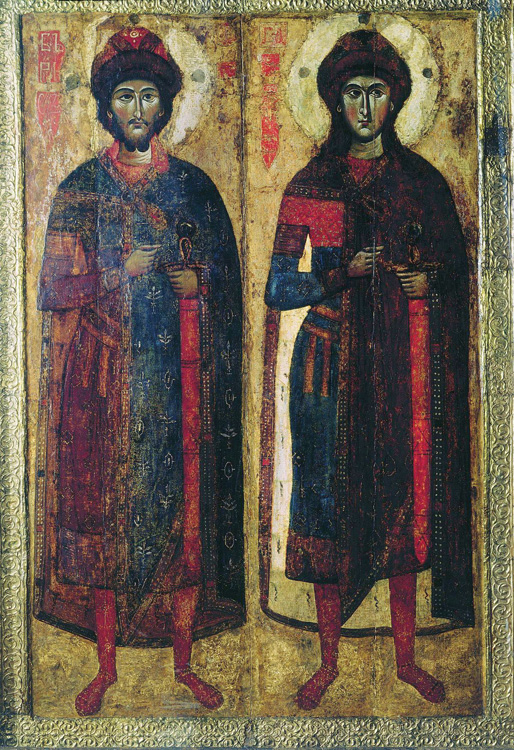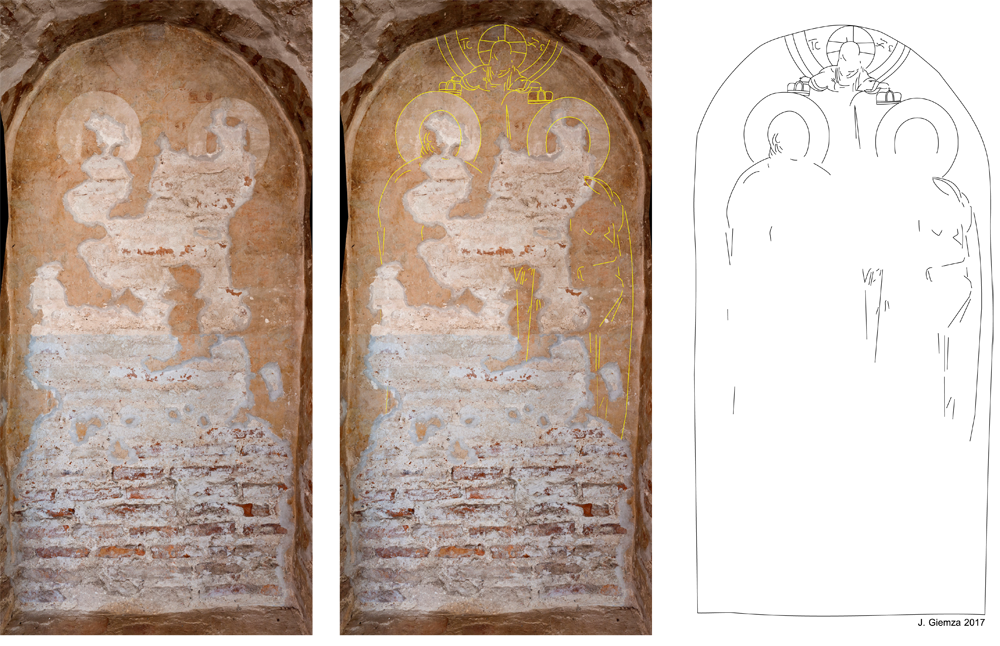Saint Martyrs Borys and Gleb niche in the northern wall of the west part of the nave of the church on Kołoży in Grodno. Iconographic reconstruction by Jarosław Giemza 2017.
 St. Boris and St. Gleb, icon from monastery of St. Sava in Novgorod, 13th century, Kyiv National Museum of Russian Art.
St. Boris and St. Gleb, icon from monastery of St. Sava in Novgorod, 13th century, Kyiv National Museum of Russian Art.
 Saint Martyrs of Borys and Gleb, 182 x 92 cm, niche in the wall of the northern part of the nave of the church on Kołoży in Grodno.
Saint Martyrs of Borys and Gleb, 182 x 92 cm, niche in the wall of the northern part of the nave of the church on Kołoży in Grodno. In the upper part of the image, Christ imposing the crown of martyrdom on the heads of the Holy Brothers.
Iconographic reconstruction by Jarosław Giemza 2017
Saint Martyrs Borys and Gleb, baptized as Roman and David.
Sons of the Grand Duke Vladimir. At Baptism, they were given the names Roman and David. From their young years, they were charitable, good-natured, mutual love, and the pleasure of the Holy Liturgy, and Boris was delighted with the Orthodox singing. In the fields given by the father, they did their best to spread the Christian faith. After the death of Saint Vladimir, the possession of the Duchy was taken over by his stepson - Świętopełk, who, fearing the loss of power and seeing the threat from Boris and Gleb, decided to kill them. The holy brothers were aware of his evil intentions, but they themselves did not want to conduct fratricidal fights and entrusted everything to the Will of God. He decided to call them to His Glory. In their people, Ruthenia gained the first Holy Martyrs and intercessors at God's throne. A treacherous death was prepared for both. Prince Borys was attacked by the nightboy, Świętopełk, on 24 July 1015, when he was with his team outside of Kiev. It happened in his tent, after prayer, when he intended to sleep. The killers pierced him with spears. His beloved servant Jerzy was also killed then. The body of Saint Boris was wrapped in canvas and taken to Świętopełk. This one realized that his brother was still breathing and ordered his heart to be pierced with a sword. The body of the martyr was secretly transported to Wyszogród and buried there. Soon after, Świętopełk sent a message to Prince Gleb, who was in Smolensk, with a lying news about his father's illness. The young prince, however, learned about the death of his brother and prayed with tears for his soul. Then the killers stood before him and cut his throat. It was September 5, 1015. In 1019 Kiev was taken by Prince Jaroslaw Mądre, who brought the body of Gleb to Wyszogród and buried his brother in the church of Saint Basil. When the temple was burned, a stone church was built, named after both Holy Martyrs, to which the brothers' bodies were moved. They turned out to be intact sometimes and shining like snow. This was considered a miracle, and on July 24 the day of the Transfiguration of the Martyrs' Relics of Boris and Gleb was established. Their relics were translated twice more. In 1240 they were hidden for fear of desecration by the approaching Tatars. They were never found again later.
Saints are depicted together in paintings. Boris as a middle-aged man with short, dark hair and a short beard, Gleb as a young man, without facial hair, with delicate facial features, with long, wavy hair. Both of them are wearing princely robes, knee-length, voluminous, purple coats, and hoods covered with fur on their heads. In each hand, a small cross and a sword. Sometimes they were shown on horses, with spears in their hands..

